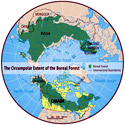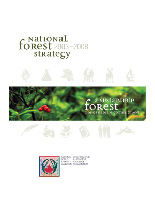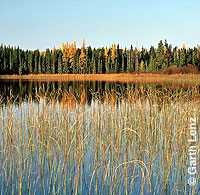
Canada Forest Policies
Forests in Canada - Federal Role The Canadian government's direct or shared roles in forests focuses on science and technology, international relations, trade and investment, industrial and regional development, national statistics, Aboriginal affairs, environmental regulations and the management of federal lands. This role and federal responsibilities are much more direct with regard to federal lands, such as Indian reserve lands, federal land designations, defense bases, and lands above the provinces.
The Canadian government's direct or shared roles in forests focuses on science and technology, international relations, trade and investment, industrial and regional development, national statistics, Aboriginal affairs, environmental regulations and the management of federal lands. This role and federal responsibilities are much more direct with regard to federal lands, such as Indian reserve lands, federal land designations, defense bases, and lands above the provinces.The federal government also represents Canada in the international arena on forest issues and is responsible for Canada's international obligations in the management of its forests. See Manitoba Wildlands page International Forest Policies, for more information on Canada's involvement in international processes concerning forests. Although federal jurisdiction respecting forest land use matters is limited, there are several federal statutes that have a bearing on land use activities which take place on public forest lands in Canada. The Canadian Environmental Assessment Act The Canada Wildlife Act The Department of Natural Resources Act The Fisheries Act The Forestry Act The Migratory Bird Convention Act The National Parks Act The Species At Risk Act Canadian Forest Service The Canadian Forest Service of Natural Resources Canada is the principal federal forest research organization in Canada, but a number of other federal departments and agencies (including the National Research Council, the Natural Sciences and Engineering Research Council, Environment Canada, Agriculture and Agri-foods Canada and Industry Canada) support research relevant to forests and forestry.
The Canadian Forest Service of Natural Resources Canada is the principal federal forest research organization in Canada, but a number of other federal departments and agencies (including the National Research Council, the Natural Sciences and Engineering Research Council, Environment Canada, Agriculture and Agri-foods Canada and Industry Canada) support research relevant to forests and forestry.Visit the Canadian Forest Service web site The Canadian Forest Service maintains Canada's National Forest Inventory, which is compiled every five years or so by aggregating provincial and territorial forest management inventories and reconnaissance level information. Visit Canada's National Forest Inventory web site Canadian Council of Forest Ministers (CCFM)The purpose of the CCFM is to provide:
The CCFM also hosts the National Forestry Database Program, which is a database of information regarding forest management and its impact on the forest resource. Visit the National Forestry Database Program web site  View the full Natural Resources Canada: Circumpolar Extent of the Boreal Forest Map (Page 3 of PDF)
View the full Natural Resources Canada: Circumpolar Extent of the Boreal Forest Map (Page 3 of PDF)Two other important and relevant CCFM initiatives for Canada's forests have been the Canadian Criteria and Indicators Framework (C&I) and the National Forest Strategy Coalition and its National Forest Strategy and Accord. Canadian Criteria and Indicators Framework (C&I)  The Canadian Criteria and Indicators (C&I) Framework of the Canadian Council of Forest Ministers (CCFM) is "a science-based framework used to define and measure Canada's progress in sustainable forest management."
The Canadian Criteria and Indicators (C&I) Framework of the Canadian Council of Forest Ministers (CCFM) is "a science-based framework used to define and measure Canada's progress in sustainable forest management."C&I criteria articulate forest values that Canadians want to enhance or sustain, while the indicators scientifically identify ways to assess the state of the forests and measure progress over time. Having a credible means of evaluating progress also helps in the process to implement Canada's national and international commitments related to sustainable forest management. Visit CCFM page on the Canadian Criteria and Indicators Framework (C&I) The first framework of (C&I) for sustainable forest management was released in 1995, and subsequent reports were published in 1997 and 2000. In 2003, the CCFM released an updated C&I framework. The next C&I report, which will use the updated framework, was scheduled for release at the end of 2005. View the Canadian Criteria and Indicators Framework page of Selected Publications The CCFM C&I initiative also feeds into the Montréal Process of establishing and reporting on criteria and indicators for the sustainable management of global temperate and boreal forests. Its liaison office is provided by the Canadian Forest Service of Natural Resources Canada. View Manitoba Wildlands International Forest Policies page for more information on the Montréal Process National Forest Strategy and Accord The Canadian Council of Forest Ministers (CCFM) is the trustee of the National Forest Strategy (NFS) and the Canada Forest Accord, and it established the National Forest Strategy Coalition (NFSC) to ensure continued and broad-based stakeholder participation in the NFS. While much of Canada's crown land forests are allocated for various industrial uses, significant crown land forests in Canada are not allocated or under tenure. The Strategy and Accord historically have referenced all forests in Canada, while mostly being applied to allocated forests which require management.  The NFSC is a coalition that includes governments, Aboriginal Peoples, the timber-based industry, non-timber forest product organizations, academia, research institutes, the recreation and tourism industry, forest practitioners, private woodlot owners, some environmental and conservation organizations, and others who have an interest in the future of Canada's forests. The primary role of the NFSC is to oversee the development, implementation and evaluation of the NFS. Members are presumed to support the current Strategy and Accord contents. The NFSC is a coalition that includes governments, Aboriginal Peoples, the timber-based industry, non-timber forest product organizations, academia, research institutes, the recreation and tourism industry, forest practitioners, private woodlot owners, some environmental and conservation organizations, and others who have an interest in the future of Canada's forests. The primary role of the NFSC is to oversee the development, implementation and evaluation of the NFS. Members are presumed to support the current Strategy and Accord contents. As of August 2009 the National Forest Strategy Coalition does not have a web site.  The current (2003-2008) National Forest Strategy is entitled A Sustainable Forest: The Canadian Commitment, and defines actions and goals, grouped under eight broad themes, for sustainable forest management in Canada. The eight themes are:
The current (2003-2008) National Forest Strategy is entitled A Sustainable Forest: The Canadian Commitment, and defines actions and goals, grouped under eight broad themes, for sustainable forest management in Canada. The eight themes are:
View the National Forest Strategy 2003-2008 A new National Forest Strategy is developed every five years, which ensures that it reflects the current definition of a sustainable forest, addresses and evaluates new and evolving forest issues, allows for new ideas to be included, and adapts to changing federal/provincial/territorial and non-government policies, practices, or budgets. View Canada's Forest Accord 1998 The Sierra Club of Canada is monitoring and auditing Canada's National Forest Strategy 2003-2008 with case studies, a report card, and a national web-hosted database of forest practices, based on goals of the National Forest Strategy. View the Siera Club of Canada data base/audit of the National Forest Strategy Senate Boreal Forest Report 1999 In June 1999, the Standing Senate Committee on Agriculture and Forestry released a report entitled Competing Realities: The Boreal Forest at Risk. The report, prepared by the Subcommittee on the Boreal Forest, examined Canada's progress in achieving the national goals of sustainable forest management and the protection of biodiversity.
In June 1999, the Standing Senate Committee on Agriculture and Forestry released a report entitled Competing Realities: The Boreal Forest at Risk. The report, prepared by the Subcommittee on the Boreal Forest, examined Canada's progress in achieving the national goals of sustainable forest management and the protection of biodiversity.The Subcommittee report concluded that Canadians must find better ways to manage the boreal forest to meet the competing realities of preserving the resource, maintaining the lifestyle and values of boreal communities, extracting economic wealth and preserving ecological values. It highlighted numerous threats to the sustainability of the boreal forest from sources such as climate change and over cutting and made 35 recommendations to address these threats and risks. The Subcommittee also concluded that the demands being placed on Canada's forests can no longer be met under the current system of management and that the boreal should be divided into three categories:
 Download the June 2003 Canadian Boreal Initiative report, The Boreal Forest at Risk: A Progress Report (PDF), which comments on progress on the fourth anniversary of the Senate Subcommittee boreal report. Download the June 2003 Canadian Boreal Initiative report, The Boreal Forest at Risk: A Progress Report (PDF), which comments on progress on the fourth anniversary of the Senate Subcommittee boreal report.Canadian Biodiversity StrategyParties to the Convention are obligated to create national strategies on biodiversity. Canada was the first developed nation to ratify the United Nations Convention on Biological Diversity (CBD) in December 1992 and in doing so, committed itself to the development of the Canadian Biodiversity Strategy.  The release in 1995 of the Canadian Biodiversity Strategy was the result of a two-year process of broad-based consultations with industry, the scientific community, conservation groups, academia, and Aboriginal groups, conducted by federal, provincial, and territorial governments.
The release in 1995 of the Canadian Biodiversity Strategy was the result of a two-year process of broad-based consultations with industry, the scientific community, conservation groups, academia, and Aboriginal groups, conducted by federal, provincial, and territorial governments.The five goals of the Canadian Biodiversity Strategy include:
 Download the Canadian Biodiversity Strategy (PDF) Download the Canadian Biodiversity Strategy (PDF)Visit Environment Canada's Canadian Biodiversity Information Network page on the Canadian Biodiversity Strategy Forest Certification
Sources for above sections:
Canadian Council of Forest Ministers (CCFM),
National Forest Strategy Coalition,
Canadian Forest Service,
The State of Canada's Forests 1999-2000,
The State of Canada's Forests 1997-1998,
Report of the Senate Subcommittee on the Boreal Forest, Competing Realities: The Boreal Forest At Risk,
Sustainable Forest Management in Canada Clear Policy - Questionable Practice,
Canadian Biodiversity Information Network,
Sustainable Forest Management: A Continued Commitment in Canada,
Environment Canada news release, April 22, 1996,
Natural Resources Canada Backgrounder - Canadian Biodiversity Strategy |
 2002-2014
2002-2014

